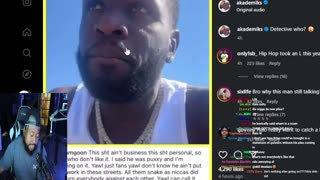Premium Only Content

Twitter Files: FBI’s Belly Button
Twitter Files: FBI’s Belly Button
In this latest release of the Twitter Files, reporter Matt Taibbi revealed how the State Department attempted to go to the media with information about suspect Twitter accounts. Twitter executives were under pressure from a a fledgling analytic/intelligence arms of the State Department to follow their requests. By 2020, Twitter executives were facing the problem of public and private agencies going straight to the media with lists of suspicious accounts from Twitter. In February of that year, as COVID was breaking out, the Global Engagement Center (GEC), an intelligence arm of the State Department went to the media with a report called “Russian Disinformation Apparatus Taking Advantage of Coronavirus Concerns.”
The GEC had flagged accounts that were saying that the Coronavirus was an engineered bioweapon. As well as accounts blaming the Wuhan Institute for the research conducted there and the CIA for the appearance of the virus. Accounts were flagged for retweeting news from the U.S. ZeroHedge which had been banned on Twitter, but had done reports about possible lab origins of the virus. The GEC had still gone directly to news stories with headlines like the AFP’s “Russia-linked disinformation campaign led to Coronavirus alarm, U.S. [United States] says.” Clemson’s Media Forensics Hub complained that Twitter had not “made a Russia attribution” in a period of time, Yoel Roth pointed out that it was “revelatory of their motives.”
He then tried to convince outsider researchers like Clemson lab to work with them instead of going straight to the media. At the same time, Twitter was doing what it can to limit the number of outside agencies that had access to Roth.
The State Department/GEC wanted to publicize a list of 5,500 accounts it claimed “amplify[ed] Chinese propaganda and disinformation.” These accounts were a sample size of the bigger nearly 250,000 list of accounts that were listed by the GEC which included Canadian officials and a CNN account.
They claimed that these accounts “display inorganic behavior and follow two or more of the 36 Chinese diplomatic twitter accounts that we have identified in the report.” This move was seen as the GEC’s attempt to use intel from other agencies to enter the “content moderation club.”
This “club” included Twitter, Facebook, the FBI, and the DHS among others. The GEC finally agreed to work with Twitter before going public. The tactic they were using to do this was one that was used before to box in the social media platform. This led to one of the few public disagreements between Twitter and state officials. When the FBI came forward and told Twitter that the GEC wanted to be included in the “industry calls” between various social media companies and government agencies, executives pushed back.
Executives from Twitter, Google, and Facebook fought back against the GEC’s involvement. The reason for the resistance was because Roth thought that the GEC was political unlike other agencies. After years of accepting agency requests, the social media platform was suddenly defiant. Roth explained that the reason they were doing this was because with the election approaching, it would pose “major risks” to bring in the GEC. Eventually the FBI went to Facebook and argued that other agencies could participate in the calls, but the FBI and DHS would be the sole “Conduits.”
Roth voiced his concerns and wanted to keep the “circle of trust small.” FBI agent Elvis Chan addressed Roth’s concerns and said that “State/GEC, NSA and CIA have expressed interest in being allowed on in listen mode only.”
-
 3:11
3:11
Top Usa NEWS FEEDER
2 years agoIdaho Supreme Court Finds No ‘Explicit Right’ to Abortion, Upholds Ban
162 -
 2:02:10
2:02:10
Akademiks
3 hours agoWar in RAT-LANTA. Young Thug vs Gunna vs Ralo vs YSL MONDO. Who Will Le Bebe Pick. FINAL CRASHOUT!
28.7K7 -
 1:13:36
1:13:36
Jeff Ahern
3 hours ago $2.24 earnedThe Sunday Show with Jeff Ahern
12.2K6 -
 LIVE
LIVE
GoodLifeGaming
4 hours ago🔴LIVE - TARKOV PVP SOLO LEARNING - 2 MIL STASH - LEVEL 14 - WOODS LOOT RUNS - POSSIBLE QUESTING
46 watching -
 29:16
29:16
The Shannon Joy Show
1 day ago🔥🔥The Extraordinary Healing POWER Of The Sun - With Dr. Chad Walding🔥🔥
23K5 -
 LIVE
LIVE
KammieKamz
2 hours agoKamz & Lydia take on REBIRTH ISLAND RANK to diamond *Agent of Chaos 😏💨 | Warzone Queen on Rumble”
32 watching -
 LIVE
LIVE
FusedAegisTV
7 hours agoHollow Knight Silksong Waiting Room ~~ pt. 2
74 watching -
 15:27
15:27
Sideserf Cake Studio
1 day ago $14.71 earnedThis K-Pop Demon Hunters CAKE is how it's done, done, done!
64.1K15 -
 54:47
54:47
Side Scrollers Podcast
1 day agoSide Scroller Presents KING OF THE KART | MASSIVE MARIO KART TOURNAMENT
98.4K2 -

Astral Doge Plays!
5 hours agoZelda NES Randomizer ~LIVE!~ Let the Randomization Begin!
26.1K1